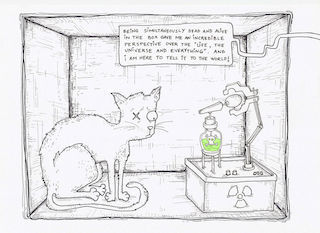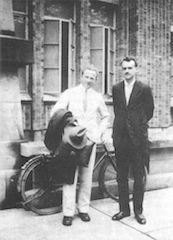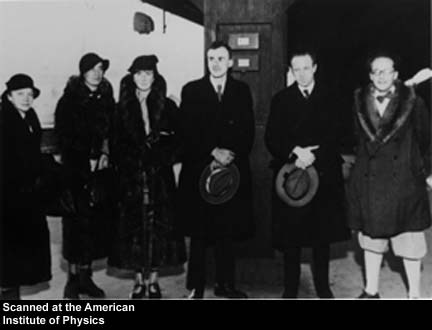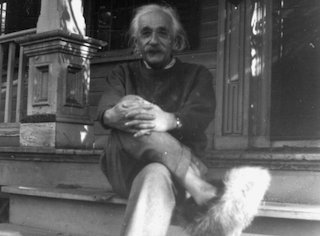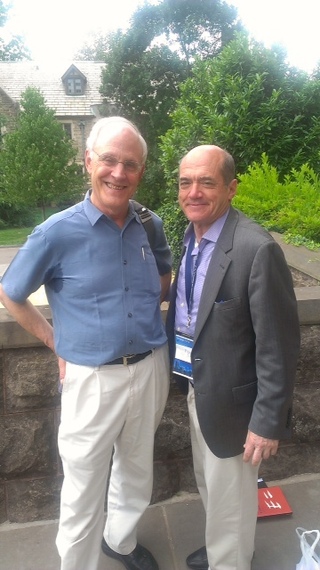Ever hear the one about the cat that was simultaneously dead and alive?
In 1935, Austrian quantum physicist Erwin Schrödinger devised a hypothetical experiment, in which a cat is placed in a sealed box with a radioactive sample, a Geiger counter and a bottle of poison. The Geiger counter is set to trigger the smashing of the bottle of poison if the radioactive material decays--which will kill the cat.
Schrödinger was out to illustrate the flaws in the "Copenhagen interpretation" of quantum mechanics, which argued that a particle exists in all its potential states at once until it is observed.
Schrödinger's Cat (source)
As Schrödinger cleverly pointed out, the Copenhagen interpretation would imply that the radioactive material would simultaneously decay and not decay in its sealed, unobserved environment. Which would mean the cat would be both alive and dead until the box is opened.
Since that's not possible, Schrödinger wrote that his hypothetical experiment "prevents us from so naively accepting as valid a 'blurred model' for representing reality."
That's what I love about quantum physicists--they explore the deepest nature of reality--and discover such fascinating things. In Part 1 of this two-part series (click here), I recommended five of my ten favorite physics articles.
Here are the next five!
6. "On the Perceptual Content of Quantum Theoretical Kinematics and Mechanics" by Werner Heisenberg (1927) articulates the German physicist's famous "uncertainty principle," which Schrödinger sought to debunk with his alive/dead cat. Heisenberg argued that you could never know the exact position and velocity of an object because you would never truly know where the object had been. This lead to the idea that the "jolt" provided to a subatomic particle by observing it could affect it.
Werner Heisenberg and Paul Dirac (source)
Schrödinger and later Einstein debunked that "observation principle", but modern physicists have confirmed that Heisenberg was onto something. His uncertainty principle was true. If you bounce a photon off an electron to try to measure it, the electron's path is changed by the momentum of the photon that just hit it.
This "uncertainty" explains lots of natural phenomena, including why our sun shines. In the sun's center, protons collide with each other - sometimes they fuse and release energy in the form of heat and light. The temperatures at the sun's center are not high enough for the protons to gain enough energy to escape, according to classical physics. Luckily, thanks to the uncertainty principle, they do gather up enough bits of energy to burst out and provide us with sunshine.
7. "The Fundamental Equations of Quantum Mechanics," was written by then-PhD candidate Paul Dirac in 1925. A friend had sent Dirac Heisenberg's paper and the brilliant young physicist was drawn to a mysterious mathematical relationship that Heisenberg had reached. Tackling it led Dirac to develop his own quantum theory, and at 31 he became the youngest person to receive the Nobel Prize in Physics. With a personality rather like Mr. Spock, Dirac was known for both his long bouts of silence and his love of pure logic. In 1928, he predicted the existence of antimatter based on his equations.
In fact, I love Dirac's work so much I am writing separate article--coming soon!
Dirac, Heisenberg, and Schrödinger, en route to pick up Nobel Prizes (source)
8. "The Present Situation in Quantum Mechanics" by Erwin Schrödinger (1935). After lots of correspondence with Albert Einstein, Schrödinger proposed his cat experiment in this legendary paper. Although the uncertainty principle he sought to debunk survived, "Schrödinger's Cat" remains an important thought experiment for modern physicists, who still use it to test their theories. It also made for a terrific Google Doodle on Schrödinger's 126th birthday, Aug 12, 2013.
9. "Can Quantum-Mechanical Description of Physical Reality Be Considered Complete?" Albert Einstein asked in this classic paper he published in 1935 while residing at 112 Mercer Street in my beloved Princeton. In this paper, Einstein and his colleagues Boris Podolsky and Nathan Rosen (known collectively as EPR) described the phenomenon now known as quantum entanglement. It explains why a hot cup of coffee cools down over time, but a tepid cup of coffee doesn't heat up. (Very!) basically, the heat energy in the coffee disperses over time as coffee and air particles bounce around and interact with each other--eventually the coffee particles lose energy and the coffee cools down until it reaches the same temperature as the air particles in the room.
Einstein on his porch at 112 Mercer Street in Princeton (source)
10. "On the Einstein Podolsky Rosen Paradox," published in 1964, was Irish physicist John Stewart Bell's response to EPR. Written during a weekend Bell spent on the Isle of Shoals in New Hampshire, it may be the greatest scientific paper of all time. In it, he proposed Bell's Interconnectedness Theorem, a "no-go theorem," meaning a theorem that states that a particular situation is not physically possible.
Specifically, Bell's theorem tests whether or not particles connected through quantum entanglement (like our coffee and air) communicate information faster than the speed of light. Experiments have since shown that our universe has a property called "non-locality." In other words, two particles can be light years apart, yet are linked to each other instantaneously. How instantaneously? Recent measurements have shown that they communicate at 10,000 times the speed of light!
Finally, it was a personal thrill of mine recently to have lunch with Dirac's finest biographer, Graham Farmelo, at the Institute for Advanced Studies in Princeton. I can't recommend his 2009 book The Strangest Man: The Hidden Life of Paul Dirac, Mystic of the Atom enough!
We met at Princeton during a conference on String Theory, another way to think about quantum physics, taking into account gravity. String Theory is in flux, as geniuses around the world try to understand our universe. And, I myself haven't mastered my own understanding of this science!
The author and David Gross, Nobel Prize winner in String Theory at Princeton this summer (source: Ricardo Andres)
About thirty years old today, String Theory was created when a scientist named Gabriele Veneziano created his own theory of dual resonance--leading many physicists to look at the world, the universe as vibrating, resonating strings. As I begin to strengthen my own knowledge on the subject, I will post more and more!

